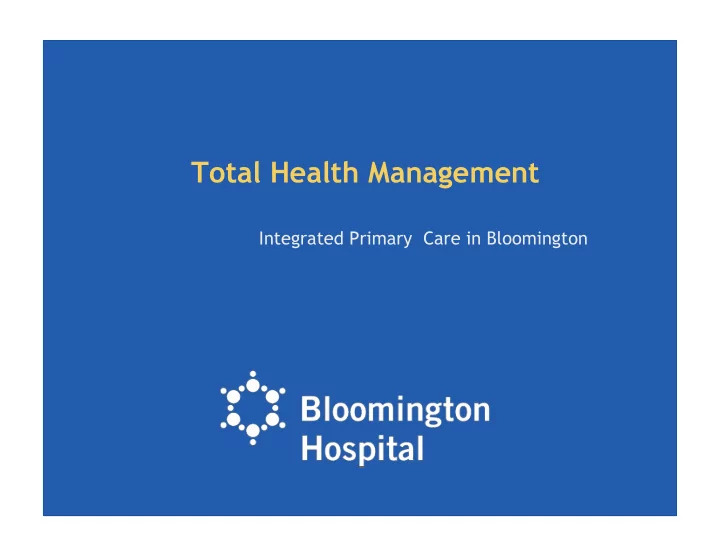

Total Health Management Integrated Primary Care in Bloomington
Current U.S. Model- Dartmouth Study • 1 million Colon Cancer/Hip Fracture/Heart Attack patients • Higher spending regions spent 60% more money • Higher use of tests, procedures, specialist care and admissions • High use of higher reimbursed, less of low reimbursement However: • Survival • Ability to resume work or activities of daily living • Satisfaction with their care • Access to care • Immunization rates • ALL SAME OR LOWER !!
RAND/McGlynn Study • 30 Acute and Chronic conditions • 439 quality indicators • 6700 charts reviewed • 54.9% received recommended care (overall) • Prevention 54.9% • Acute care 53.5% • Chronic conditions 56.1% • Best= cataract 78.7% • Worst= alcohol dependence 10.5% NEJM Vol 348:2635-45 2003
Quality/Cost= Value • National quality indicators improving 3.1%/year • Insurance Costs increasing 11-15 %/year • Most quality/safety data is institution based • The National Business Coalition on Health (5/07) noted 30% of health expenses attributed to overuse, underuse, & misuse Four Recommendations: 1 Community based & standardized performance measures 2 Reported to public 3 Reform payment system to reward what you want 4 Informed choice for customers and buyers
Personal Responsibility & Integrated Sustainable Accountability Health Risk Health Portal/PHR Health Risk Health Portal/PHR Appraisals Programs Appraisals Wellness Wellness Fitness Center Programs Statement of Purpose: Fitness Center Programs Shift the paradigm of the Health Plan current healthcare model Physician from episodic or Disease Partners Partners Disease Spiritual Health transactional delivery to the Spiritual Health E Management Management proactive management and m P p promotion of health and a l r o t y wellness for our region. n Health Advocate e Community e r Health Advocate r & Case Mgnt. s & Case Mgnt. Partners Data Integration Data Integration & Management & Management Total Health Health Government Total Total Health O Behavioral Health r Partners Management Management g Behavioral Health Management a a n n i d z a V Benchmarking & F t Benchmarking & u a i o n Best Practices P l d u n Health Plan Design Best Practices a i r Health Plan Design e a n t Technology l g n M e A r s e c Partners a c s o Citizen u Primary Care u r Primary Care n e Quality Outcomes Partners t m Quality Outcomes a b e i e n l n i t i t c y i Specialists d Specialists e M s Work Environment e Steering Committee Members: v Work Environment d Steve Deckard, V.P. Human Resources i e t s n Larry Bailey, C.O.O. a e Occupational Health B Absence c Occupational Health Brian Whitman, V.P. Marketing, Business Development & Community n Absence d I Relations Aligned Policies & Practices e Management d c e Carol Weiss-Kennedy, Director, Community Health Education Management n n e g Lee McKinley, M.D. d i i l v Rick Barton, Director, Organization Effectiveness A E Todd Rowland, M.D., Director, Medical Informatics Paul Van cleave, V.P., SIHO Insurance Services Thomas Kuhn, Director Promptcare & Center for Occupational Health Mary Ann Valenta, Director, Managed Care
Patient Centered Medical Home Joint Principles: 1. Personal physician 2. Physician lead team of individuals who take collective care of the needs of the patient 3. Whole person orientation 4. Coordinated and integrated across all elements of care 5. Quality and safety is paramount 6. Enhanced access 7. Payment reflects coordination, quality instead of quantity, and is adjusted for disease severity
Data driven medical practice • Collect data on physician-sensitive process and outcomes • Patient satisfaction feedback to practice and referral physicians/hospitals/labs/radiology • Track source of referrals to clinic • Secondary/Tertiary care to best providers, not “who is on- call” • Pharmacy Medication management • PBM data from insurers • IT/Management support • Decision support for individuals and populations
Quality & Safety • Continuous care, especially post acute settings • Continuous data on: PQRI, HEDIS,IT,CMS, Anthem, Crimson indicators • Employer based Wellness, chronic disease, IHAP • Remote EMR access • Staff education on safety culture, team dynamics and self care
Is there Return on Investment? • 36 National Demonstration projects revealed: • decreased overall costs at 1 year • Improved patient and physician satisfaction • Decreased use of ER for low acuity problems • Improved access and preventive care • Decreased use of tests, specialists and procedures
This is all very nice but….. #1 No incentive for specialists/hospitals to help in the effort to reduce overall costs (still volume based) #2 No arrangements which allow primary care practices to share in the savings (i.e. see less patients per hour but manage individuals and a population cost effectively)
Accountable Care Organizations • An employer who is self insured and can re-align incentives to match needs to benefits and decrease waste • A Clinical Integration organization composed of physicians who want to offer a population improved quality with lower overall costs • A federal program which rewards quality management over quantity. Without one of these Patient Centered Medical Homes are not sustainable
Bloomington solutions? • Provide an evidence based model of care delivery • Look at a patient centered approach, increase access • Provide a model for physicians-in-training to experience* • Improve post hospitalization care • Clinical Integration-Partnership with payers and other providers (Clarian Quality Partners) • Attract new physicians to primary care & decrease burnout for those remaining in practice • Convince Local companies to re-align health plans to reward new behaviors * IU/Clarian Bench-Bedside-Community-World curriculum -stresses continuity of care experience and community service
References Fisher, et al Annals of Internal Medicine 2/18/03 Vol. 138 No. 4 pg. 273-298 Joint Principles of the Patient Centered Medical Home (AAFP,AAP,ACP,AOA , 2007) Ritterhouse, et al NEJM 12/10/2009 361; 24 National Business Coalition on Health May 2007
Recommend
More recommend